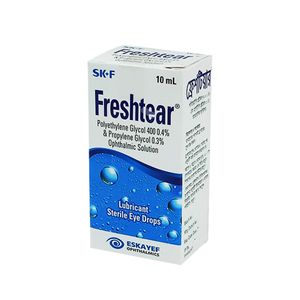Freshtear Uses, Dosage, Side Effects and more
The mechanism of action is thought to be due to its unique gelling and lubricating system formulated to adjust to each user's individual tear PH. When Polyethylene Glycol & Propylene Glycol combine with natural tears, a soft gel forms a network of protection over the eye surface. Since it promotes a healthy environment in eye surface, damaged surface cells of eye can repair more easily.

| Attribute | Details |
|---|---|
| Trade Name | Freshtear |
| Generic | Polyethylene Glycol + Propylene Glycol |
| Weight | 0.4%+0.3% |
| Type | Eye Drops |
| Therapeutic Class | Drugs for Dry eyes |
| Manufacturer | Eskayef Bangladesh Ltd |
| Available Country | Bangladesh |
| Last Updated: | January 7, 2025 at 1:49 am |
Uses
This combination eye drop is used for the temporary relief of burning and irritation due to dryness of the eye.
Eye Drops is a sterile eye drops containing Polyethylene Glycol & Propylene Glycol, which is used to relieve dry, irritated eyes. It keeps the eye moist, helps to protect the eye from injury and infection, and decreases symptoms of dry eyes such as burning, itching, and foreign body sensation.
Freshtear is also used to associated treatment for these conditions: Chronic Constipation, Constipation, Dry Eye Syndrome (DES), Dry Eyes, Occasional Constipation, Bowel preparation therapy, Eye lubricationDry Eyes, Ocular Irritation, Eye lubrication, Scalp Health
How Freshtear works
Osmotic laxatives contain substances that are poorly absorbable and draw water into the lumen of the bowel. Polyethylene glycol functions is an osmotic laxative that causes increased water retention in the lumen of the colon by binding to water molecules, thereby producing loose stools.
Dosage
The frequency of instillation of drops and the duration of treatment will vary depending upon the severity of the underlying condition and the response to treatment. Usually instill 1 or 2 drops in the affected eyes.
It should always be taken by mouth. Measure the dose using the supplied cup, stir and dissolve in a glass of water, juice, coke, coffee or tea. Taking more than the prescribed dose may cause loss of fluid due to severe diarrhea.
Duration of Treatment
Polyethylene Glycol achieves its best results when used between one and two weeks. It may be discontinued after several satisfactory bowel movements. Should unusual cramps, bloating, or diarrhea occur, consultation with physician is needed. Polyethylene Glycol is intended for up to a two-week course of therapy. It should not be used for a longer time unless directed by a physician. After successfully completing the Polyethylene Glycol therapy (usually between one and two weeks) discussion with a physician is needed to change lifestyle that may produce more regular bowel habits (adequate dietary and fluid intake, regular exercise).
How Long Does It Take to Work?
How Long Does It Take to Work? see here Freshtear
Side Effects
Generally well tolerated. It should not be used if allergic condition occurs to any ingredients of the product.
Toxicity
The oral LD50 of PEG 3350 in rats is 22000 mg/kg.
There is limited clinical information on the overdose of polyethylene glycols. Based on the pharmacological action of the compound, severe diarrhea may be suspected. Overdose of polyethylene glycols should be responded with symptomatic and supportive care.
Precaution
For external use only. Do not use if the product changes color or becomes cloudy or also if anyone is sensitive to any ingredient of this product. This product may temporarily cause blurred vision right after being placed in the eye(s). Never touch tip of container with any surface to avoid contamination & replace cap after each use.
Interaction
No specific drug interactions have been demonstrated.
Volume of Distribution
Following a two-day split-dosing regimen of an oral suspension containing 140 grams of PEG 3350 in healthy subjects, the mean volume of distribution was 48,481 L.
Elimination Route
Following a two-day split-dosing regimen of an oral suspension containing 140 grams of PEG 3350 in healthy subjects, the mean Cmax was 2.7 mcg/mL and the mean Tmax was 3 hours. Typically, polyethylene glycols with a high molecular weight are poorly absorbed from the gastrointestinal tract following oral administration.
Half Life
Following a two-day split-dosing regimen of an oral suspension containing 140 grams of PEG 3350 in healthy subjects, the mean half life was 4.1 hours.
Clearance
There is limited information on the clearance rate of polyethylene glycols.
Elimination Route
Following administration of an oral suspension containing 140 grams of PEG 3350 in healthy subjects, up to 85% to 99% of the compound was excreted in the feces.
Pregnancy & Breastfeeding use
Pregnancy: Due to the negligible systemic exposure and the lack of pharmacological activity, this medication can be used during pregnancy.
Nursing Mothers: It is not known whether this medication is excreted in human milk. Because many drugs are excreted in human milk, caution should be exercised when this product is applied to a nursing woman.
Contraindication
Hypersensitivity to any of the components of the medication.
Special Warning
Pediatric Use: Safety and efficacy in pediatric patients have not been established.
Acute Overdose
There have been no reports of accidental overdosage. In the event of overdosage diarrhea would be the expected major event. If an overdose of drug occurred without concomitant ingestion of fluid, dehydration due to diarrhea may result. Medication should be terminated and free water administered.
Storage Condition
Store below 30°C in a cool and dry place protected from light. Keep out of reach of children. Do not use after 30 days of frst opening.



